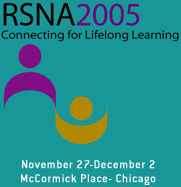
Abstract Archives of the RSNA, 2005
SSK06-03
Characterization of Focal Liver Lesions with Contrast-enhanced Ultrasound and SonoVue: Enhancement Patterns and Diagnostic Value
Scientific Papers
Presented on November 30, 2005
Presented as part of SSK06: ISP: Ultrasound (Liver: Contrast)
Ying Dai MD, Presenter: Nothing to Disclose
Min Hua Chen MD, Abstract Co-Author: Nothing to Disclose
Kun Yan, Abstract Co-Author: Nothing to Disclose
Wei Wu, Abstract Co-Author: Nothing to Disclose
Zhi Hui Fan, Abstract Co-Author: Nothing to Disclose
Shan Shan Yin, Abstract Co-Author: Nothing to Disclose
To evaluate the diagnostic value of contrast enhanced ultrasound (CEUS) using SonoVue and contrast tuned imaging technique in the characterization of focal liver lesions.
Three hundred and four patients with 367 solid focal liver lesions which were considered indeterminate at conventional ultrasonography were examined using low mechanical CEUS. The diagnosis was made by three readers independently before and after CEUS according to the standard diagnostic criteria. The enhancement patterns of all the lesions were also recorded. The final diagnosis was achieved by biopsy or surgical pathology, typical manifestation on contrast enhanced CT/MRI or more than 6 months follow-up.
The typical enhancement pattern of HCC was homogeneous or heterogeneous enhancement with fast washout (79.6%, 113/142 lesions, while that of hemangioma was peripheral ring or nodular enhancement with centripetal fill-in and no wash out (63.4%, 45/71 lesions). The enhancement patterns of cholangiocarcinoma and inflammatory lesions were both heterogeneous enhancement with fast wash out (75%, 3/4 lesions, 80%, 4/5 lesions, respectively). There was no typical pattern for liver metastasis during the arterial phase but all of them became hypoechoic during the late phase. All the 22 focal fatty changes and 21 of the 31 regenerative nodules enhanced the same as the liver parenchyma, the 7 necrotic lesions showed no enhancement. Before CEUS, the diagnostic accuracy of the three readers were 42.2%, 32.7%, 28.3%, respectively and the agreed accuracy was 27.0%, while after CEUS, the diagnostic accuracy were significantly improved with 86.6%, 86.9%, 85.6% for the 3 readers, respectively and the agreed accuracy was 81.5% (p<0.001).
Contrast enhanced ultrasound with SonoVue could improve the diagnostic ability in characterization of focal liver lesions.
Dai, Y,
Chen, M,
Yan, K,
Wu, W,
Fan, Z,
Yin, S,
Characterization of Focal Liver Lesions with Contrast-enhanced Ultrasound and SonoVue: Enhancement Patterns and Diagnostic Value. Radiological Society of North America 2005 Scientific Assembly and Annual Meeting, November 27 - December 2, 2005 ,Chicago IL.
http://archive.rsna.org/2005/4417334.html

